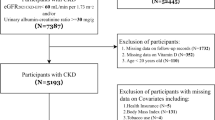Abstract
In alcoholics, exposure of Kupffer cells to intestinal-borne Gram-negative bacteria increases free radical release, which may, in turn, enhance cytokine secretion, creating a positive feedback loop, which contributes to liver inflammation. Impaired antioxidant mechanisms further aggravates this scenario. Some trace elements, such as selenium, are main cofactors of antioxidant enzymes. Some authors have found low Se levels in alcoholics in relation either with undernutrition, liver dysfunction, or intensity of alcoholism, but in general, Se supplementation has no effect on survival. In this study we measured serum Se in 16 controls and 76 alcoholics, 34 of them cirrhotics, 68 of whom were followed up for a median period of 38 months; 17 died during this period. Se levels were lower in patients than in controls and were related to prothrombin activity and nutritional status, more closely to this last parameter (stepwise logistic regression analysis). Patients who died showed lower Se values than those who survived. Se values over the median were associated with better survival, assessed by Kaplan–Meier curves and log-rank test. However, in multivariate analysis (Cox regression model), prothrombin activity displaced serum Se as a prognostic factor. We conclude that serum Se levels are low in alcoholics; these low values depend more heavily on impaired nutrition but also on liver dysfunction; although low Se levels were associated with a higher mortality, prothrombin activity displaced serum Se when survival was assessed using Cox’s regression model.

Similar content being viewed by others
References
Bird G (1994) Interleukin-8 in chronic alcoholic liver disease. Acta Gastro-Enterol Belg 57:255–259
Fujimoto M, Uemura M, Nakatani Y et al (2000) Plasma endotoxin and serum cytokine levels in patients with alcoholic hepatitis: relation to severity of liver disturbance. Alcohol Clin Exp Res 24:48S–54S
Shiratori Y, Takada H, Hikiba Y et al (1993) Production of chemotactic factor, interleukin-8, from hepatocytes exposed to ethanol. Hepatology 18:1477–1482
Nanji AA, Jokelainen K, Rahemtulla A et al (1999) Activation of nuclear factor kappa B and cytokine imbalance in experimental alcoholic liver disease in the rat. Hepatology 30:934–943
Kono H, Rusyn I, Yin M et al (2000) NADPH oxidase-derived free radicals are key oxidants in alcohol-induced liver disease. J Clin Invest 106:867–872
Poli G (2000) Pathogenesis of liver fibrosis: role of oxidative stress. Mol Aspects Med 21:49–98
Loguercio C, Federico A (2003) Oxidative stress in viral and alcoholic hepatitis. Free Radic Biol Med 34:1–10
Cederbaum AI (1991) Microsomal generation of reactive oxygen species and their possible role in alcohol hepatotoxicity. Alcohol Alcohol (Suppl 1):291–296
Tuma DJ (2002) Role of malondialdehyde–acetaldehyde adducts in liver injury. Free Radic Biol Med 32:303–308
Stewart SF, Vidali M, Day CP, Albano E, Jones DE (2004) Oxidative stress as a trigger for cellular immune responses in patients with alcoholic liver disease. Hepatology 39:197–203
Manzanares Castro W (2007) Selenio en pacientes críticos con respuesta inflamatoria sistémica. Nutr Hosp 22:295–306
Berger MM, Chioléro RL (2007) Antioxidant supplementation in sepsis and systemic inflammatory response syndrome. Crit Care Med 35(Suppl 9):S584–S590
Stewart S, Prince M, Bassendine M et al (2007) A randomized trial of antioxidant therapy alone or with corticosteroids in acute alcoholic hepatitis. J Hepatol 47:277–283
Campillo N, Viñas P, López-García I, Hernández-Còrdoba M (2000) Selenium determination in biological fluids using Zeeman backgound correction electrothermal atomic absorption spectrometry. An Biochem 280:195–200
Tormo-Cantos A, Sanatolaria F, González-Reimers E et al (1994) Short-term prognostic value of subjective nutritional assessment in general medical patients. J Nutr Med 4:287–295
Sánchez-Pérez MJ, Gonzalez-Reimers E, Santolaria-Fernandez F et al (2006) Lipid peroxidation and serum cytokines in acute alcoholic hepatitis. Alcohol Alcohol 41:593–597
Dworkin BM, Rosenthal WS, Gordon GG, Jankowski RH (1984) Diminished blood selenium levels in alcoholics. Alcohol Clin Exp Res 8:535–538
Aaseth J, Smith-Kielland A, Thomassen Y (1986) Selenium, alcohol, and liver diseases. Ann Clin Res 18:43–47
Johansson U, Johnsson F, Joelsson B, Berglund M, Akesson B (1986) Selenium status in patients with liver cirrhosis and alcoholism. Br J Nutr 55:227–233
Tuluvath PJ, Triger DR (1992) Selenium in chronic liver disease. J Hepatol 14:176–182
Dworkin BM, Rosenthal WS, Stahl RE, Panesar NK (1988) Decreased hepatic selenium content in alcoholic cirrhosis. Dig Dis Sci 33:1213–1217
Milman N, Laursen J, Podenphant J, Asnaes S (1986) Trace elements in normal and cirrhotic human liver tissue I. Iron, copper, zinc, selenium, manganese, titanium, and lead measured by X-ray fluoresnece spectrometry. Liver 6:111–117
Korpela H, Kumpulainen J, Luoma PV, Arranto AJ, Sotaniemi EA (1985) Decreased serum selenium in alcoholics as related to liver structure and function. Am J Clin Nutr 42:147–151
Casaril M, Stanzial AM, Gabrielli GB et al (1989) Serum selenium in liver cirrhosis: correlation with markers of fibrosis. Clin Chim Acta 182:221–227
Van Gossum A, Neve J (1995) Low selenium status in alcoholic cirrhosis is correlated with aminopyrine breath test. Preliminary effects of selenium supplementation. Biol Trace Elem Res 47:201–207
Loguercio C, de Girolamo V, Federico A et al (1997) Trace elements in chronic liver diseases. Trace Elem Med Biol 11:158–161
Girre C, Hispard E, Therond P, Guedj S, Bourdon R, Dally S (1990) Effect of abstinence from alcohol on the depression of glutathione peroxidase activity and selenium and vitamin E levels in chronic alcoholic patients. Alcohol Clin Exp Res 14:909–912
Cho HK, Yang FL, Snook JT (1991) Effect of chronic ethanol consumption on selenium status and utilization in rats. Alcohol 8:91–9
Wenzel G, Kulinski B, Ruhlman C, Ehrhardt D (1993) Alcohol-induced toxic hepatitis—a “free radical” associated disease. Lowering fatality by adjuvant antioxidant therapy. Z Gesammte Inn Med 48:490–496
Phillips M, Curtis H, Portmann B, Donaldson N, Bomford A, O’Grady J (2006) Antioxidants versus corticosteroids in the treatment of severe alcoholic hepatitis—a randomised clinical trial. J Hepatol 44:784–790
Author information
Authors and Affiliations
Corresponding author
Rights and permissions
About this article
Cite this article
González-Reimers, E., Galindo-Martín, L., Santolaria-Fernández, F. et al. Prognostic Value of Serum Selenium Levels in Alcoholics. Biol Trace Elem Res 125, 22–29 (2008). https://doi.org/10.1007/s12011-008-8152-5
Received:
Accepted:
Published:
Issue Date:
DOI: https://doi.org/10.1007/s12011-008-8152-5




